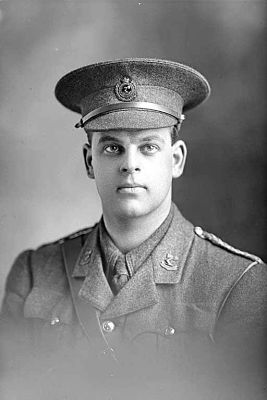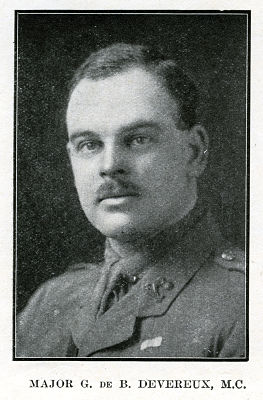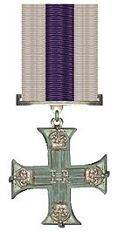WW1 Major Geoffrey de Bohun Devereux M.C.(twice) 12/1190
Geoffrey de Bohun Devereux (12/1190) was born on 10 April 1890, one of three sons and four daughters of Customs Officer, the Hon.
Henry De Bohun (1848 – 1909), second son of the 15th Viscount Hereford, and Maud Philippa Devereux, (nee Salamon) (1852 – 1934) of ‘Kundibar’, 72, Market Rd., One Tree Hill, Auckland. [1]
One brother, Rodney Talbot Devereux (435) a Corporal, was one of the four New Zealand soldiers killed in action at Reitfontein, South Africa in 1902. The younger brother Godfrey Vaughan Devereux (67593) born on the 24 April 1893 also fought in the first World War and afterwards returned to New Zealand. Geoffrey attended Auckland Grammar School in 1901 where he won prizes in Arithmetic and Languages. On leaving school, he joined the staff of the Bank of Australasia and subsequently worked for the Farmers’ Union Trading and Indenting Association.
He joined College Rifles Rugby and Football Club, Remuera, on 26 April 1910, in the Territorials, through to September 1912 when he transferred to the 3rd Regiment (CRO) as a Corporal. In August 1912, he gained a commission and on 8 January 1914 he was promoted to Lieutenant. He joined up on 21 October 1914 and was appointed Captain on posting to the 1st Auckland Infantry Regiment on 21 November 1914. He embarked in Wellington for Egypt on 14th December 1914 with the 2nd Reinforcements. He was attached to the 3rd Auckland Company on arrival in Egypt.
Geoffrey was involved in the Gallipoli landing, as Transport Officer on H.M. Transport ‘Lutzow’, organising the delivery of men and the evacuation of the wounded. He later went ashore on 6 June 1915 and served with the Auckland Battalion through the heat of summer but then his health declined and he was declared unfit for service. He was invalided to England on 20 August 1915 and admitted to the Royal Free Hospital on 14 September 1915. By January 1916, he had recovered and returned to Egypt. He was confirmed as Captain on 1 March 1916 and was second in command of the 6th Hauraki Company, 1st Battalion, Auckland Infantry. He was sent to France in April 1916 and joined the N Z Infantry Brigade Headquarters at Armentieres on 29 June 1916. Geoffrey saw fighting at the Battle of the Somme and on the front line over the winter of 1916 -1917. He became Acting General Staff Officer and performed staff duties from March to June 1917. [2] On the 15 September 1917 he was promoted to Major. On 6th July 1917 he rejoined the 1st Auckland Battalion as 6th Company Commander.
He was awarded a Military Cross in November 1917 and again in March 1918 for Acts of Gallantry in the field at Passchendaele:
For conspicuous gallantry and devotion, though he lost all his Company Officers early in the advance, he directed the attachment of his Company in a most able manner and captured all his objectives. He did excellent work in securing the captured position and sent in most valuable reports. He set his company a splendid example of courage and their success was largely due to his efforts [3, 4, 5]
Fought between July and November 1917, the Passchendaele Campaign around the Belgian city of Ypres has come to symbolise the dreadful conditions encountered by soldiers. In heavy rains that reduced the ground to mud, both sides carried out a series of offensives where gains were usually measured in yards rather than miles. [6] Geoffrey was granted two months’ leave during March-April in 1918, which he took in New Zealand. In May 1918, he was back in England on a senior officers training course in Chelsea, London, before rejoining the 1st Battalion on 21st September 1918 as a Company Commander in France. In 1918 Western Front Offensive, the New Zealand Division came out of reserve for the final phases of the Battle of the Canal du Nord (27 September 1918 –1 October 1918). Fighting their way through the main Hindenburg Line, the 1st New Zealand Infantry Brigade seized the town of Crèvecoeur on the final day of the battle, establishing a valuable foothold across the Scheldt (Escaut) Canal in the process. In effect, the New Zealanders had already broken through the ‘Masnières–Beaurevoir line’, a trench system prepared hastily behind the Hindenburg Line on which the Germans hoped to hold the Allied advance in this sector, with many casualties. [7]
Geoffrey was killed in action at Le Cateau, France on 1 October 1918, at the age of 28. He is buried in the Flesquieres Hill British Cemetery in France.[8]
As well as being awarded two Military Crosses for Bravery, Geoffrey was also awarded the 1914-1915 Star, the British War Medal, and the Victory Medal. There is an obituary to him in the Auckland Grammar School Chronicle. Third Term, 1918:
The many friends of Major Geoffrey de Bohun Devereux will be grieved to hear of his death. He was killed in action on the 1st October. Major Devereux left New Zealand with the 2nd Reinforcements, Auckland Infantry Regiment, and was in Egypt, landed in Gallipoli, and saw service in France, where he won the Military Cross. He came out to New Zealand on furlough not many months ago, and then returned to England. Major Devereux was the third son of the Hon. H. de B. Devereux, who also lost a son, Rodney, in the Boer war. – Evening Post, Volume XCVI, Issue 92, 15 October 1918, Page 2
He is remembered on the:
• Memorial plaque, Auckland Garrison Officers Club (although his name has been misspelt),
• St Mary’s Church (part of Holy Trinity Cathedral), corner St Stephens Avenue and Parnell Road, Auckland and
• Roll of Honour, College Rifles, Rugby Union Football and Sports Club, 33 Haast Street, Remuera, Auckland


